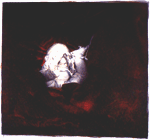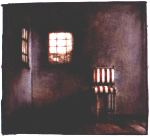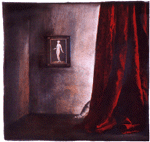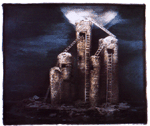Melinda Kovács – portfolio
Varró Attila
After six feverish days a light and shiny vision fell on his eyes. He saw a rat quivering on beetle wings over the white-scrubbed dissecting table. When the quiver stopped, the apparition began to speak in a tinkling, childish voice: ’You’re moving into further distances instead of coming home. You maust bend over the well. If you want to feel heartbeat, put your finger on the pulse in the moment of birth.’ (The Famulus of Armageddon by Bakáts Tibor Settenkedo)
In the winter of 1392 Nicolas Flamel, a notary at the University of Paris and an acknowledged expert of alchemy succesfully changed a pound of mercury into the same quantity of silver. The philosopher’s stone, which he invented to produce this extraordinary chemical reaction was a mysterious deep-red powder: he had read about its mode of preparation in a manuscript written by an ancient Jewish alchemist named Abraham. The only eye-witness of the miracle was Flamel’s beloved wife, Perrenelle who helped her husband with his experiments from the very first moment they’d met. After their success they never apply the powder again, though rumours say Nicolas mixed it into the paint he used on his frescoes put on the arcades of Charnier des Innocents, a famous cemetery in Paris existed until the beginning of the 19th century.
Nearly 600 years later the magical red powder reappeared on the frescoes of a young and highly talented photographer, Kovács Melinda - a female alchemist of the second millenium who used its power to transmutate her bleak, black and white photograpghs into vivid personal pictures of a woman’s mind. She colours them by hand and special chemical methods: her denial of the shades and tints of reality originates from a strong desire to create her own world, a free universe where the strict laws of Nature loose their grasp. She is an experimentalist, a
rebel against conventions of form and academical categories, the modern descendant of the medieval Perrenelle Flamel or the first female representatives of Greek-Egyptian alchemy, Cleopatra and Maria the Jewess.
Her magic is neither black nor white. It’s somewhere in the middle, it’s Sienna Gebrannt, as the title of her Vienna-series says in which she applies reproductions of oil-paintings by Bernardo Bellotto, a 18th century Genovese artist. In her interior-series named Terrarium the walls are decorated with portraits of famous Dutch masters, rigid illustrations from The History of Inquisition and anatomical pictures: small windows opening to the classical arts in the claustrophobic world of photorealism. Her adherence to reproductions reflects the inconsistent relation between creative imagination and reproduction of reality in the art of photography. “In my view photography has to live within the narrowest boundaries of all the techniques available for making picture“ she proclaims, “Photographic images are always reproductions of the photographer’s vision.“
Making pictures. Kovács Melinda does make her pictures in every sense. With her predesigned compositions, hand-made models and artificial environments she controls the creative process from the very beginning. Taking pictures can be considered only a momentary act compared to the amount of time she dedicates to building sculptures or colouring the developed photos subsequently. Creating similes of the Life would not do for her - she wants to create Life such as the most daring alchemists, the first ancestors of Dr. Frankenstein. Her darkroom is a secret laboratory in which she experiments with various chemicals, assembles three-headed chickens, winged rats and bizarre articulata in order to tell her fairy tales about solitary artists or renegate scientists, her favourite heroes. In the Middle Age she must have been outcast, exorcised or burned as a heretic. She is a witch with a camera, a sorceress in Sienna Gebrannt.
| Melinda Kovács: | |
| 1969 | born in Esztergom, Hungary. |
| 1987 | Started taking photos. |
| 1989 - 91 | Took courses at the Photo School Desi Huber, Budapest. |
| 1992-94 | Photo art scholarship awarded by the Hungarian Ministry of Culture and Education. 1995 Scholarship awarded by the Commercial and Credit bank. |
| 1998 | 3-month scholarship awarded by KulturKontakt Austria in Wien. |
| 1999 | 1-year scholarship awarded by Hungart (Association of Visual Artists) |
| Solo Exhibitions: | |
| 1991 | Budapest Fotóclub, Hungary. |
| 1993 | Fészek Klub Budapest, Hungary. Duna Múzeum Esztergom, Hungary. Kunst und Raum Galerie, Wien, Austria. |
| 1994 | Duna Múzeum - Central Europe Gallery, Esztergom, Hungary. Vasarely Múzeum, Pécs, Hungary. Hungarian Culture Center, Bratislava, Slovakia. |
| 1996 | Bolt Galéria, Budapest, Hungary. 1997 Gromek galéria, Budapest, Hungary. |
| 1998 | Duna Múzeum Esztergom, Hungary. Vintage galéria, Budapest, Hungary. |
| 1999 | Month of Photography, Bratislava, Slovakia. |

From the series Siena Gebrant I.,
1999

From the series Siena Gebrant III.,
1999

From the series Siena Gebrant IV.,
1999

From the series Landscape X.,
1998